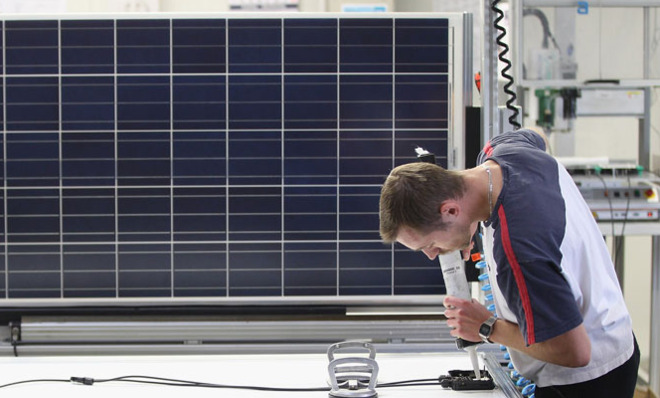3 solar start-ups that could change the energy industry
The solar industry has a few rising stars

In the last four decades, solar energy technology has improved by leaps and bounds.
In the 1970s, solar electricity cost about $76 per watt to produce, and the first photovoltaic cell could turn only about 8 percent of the light it absorbed into electricity. Now, solar costs about 58 cents a watt, and is getting more efficient every year.
But the industry still has a long way to go — solar still only accounts for 0.7 percent of the world's total energy use. The U.S. Department of Energy estimates that solar now costs $156.90 per megawatt hour, compared to between $65.50 and $132 per MW/h for natural gas, which means it remains uncompetitive economically, said John Aziz earlier this year at The Week. To beat this, solar panels will need to be even more efficient.
The Week
Escape your echo chamber. Get the facts behind the news, plus analysis from multiple perspectives.

Sign up for The Week's Free Newsletters
From our morning news briefing to a weekly Good News Newsletter, get the best of The Week delivered directly to your inbox.
From our morning news briefing to a weekly Good News Newsletter, get the best of The Week delivered directly to your inbox.
Cost and efficiency remain the focus of many new solar start-ups. Here are three young companies that are tackling those issues head on.
Mosaic
More individuals are installing solar systems in their homes, and large companies are incorporating solar into their facilities as well. But "mid-size projects — such as the installation of photovoltaic panes on a community center or a school — often can't raise the money to get their solar projects off the ground," says National Journal.
A solar energy investment platform, Mosaic, tackles that problem by allowing individuals to share ideas for solar projects, and solicit money to fund them. It's been called "the Kickstarter for solar," but Mosaic boasts one key difference: The investments at Mosaic are loans — not donations — which will be paid back, typically over about 10 years, with a rate of return about four to seven percent annually.
A free daily email with the biggest news stories of the day – and the best features from TheWeek.com
The company was founded in 2011, started soliciting money in January, and now has 2,000 clients in 44 states, says The New York Times. It has so far processed $4 million in financing. The National Journal explains why this could fill a huge gap in green energy needs:
Right now, without Mosaic, the most common way to buy a solar system for a residence or business is through a bank-financed loan. Banks have stringent lending requirements, however, and people with low income or bad credit are often shut out from the possibility of receiving a loan. Banks are also more likely to finance commercial-scale projects like a solar farm owned by a utility company than they are to pick up the tab for a mid-sized installation. [National Journal]
QBotix
The California start-up QBotix has developed robots to help close the efficiency gap. Programmed to move around a solar installation, the QBotix bot tilts the panels to "follow the sun and maximize their output," says The New York Times.
As a result, each panel can generate as much as 40 percent more electricity than it would with the current "fixed-tilt" system.
“The solar market is very competitive, and people literally fight over single cents per watt, so by allowing such a dramatic decrease in overall power plant costs, we are bringing a lot of value to the market,” Wasiq Bokhari, QBotix's chief executive, told the Times.
Five of the bot-systems are already operating at solar farms in the U.S. and Japan.
Sol Voltaics
The Swedish company Sol Voltaics uses nanotechnology — technology made from materials a billionth of a meter in length — to build cheaper, more efficient solar cell modules.
This involves incorporating "gallium arsenide nanowires" into solar cells. Gallium arsenide has been used in solar panels for years "because of its high reliability and high efficiency at converting light into electricity," says VentureBeat. But it's typically expensive to make.
To combat this problem, Sol Voltaics has developed a process called Aerotaxy — which involves mixing vapors in the air — for making gallium arsenide at a lower cost. In addition, Sol Voltaics can make solar cells with less gallium arsenid altogether, even as they convert the same amount of light into electricity.
With SolInk, as the project is called, a panel's efficiency can be boosted from 20 to 25 percent.
After raising $17 million from investors, Sol Voltaics plans to have pilot commercial production up and running in 2015. VentureBeat explains the strategy:
The way [Sol Voltaics CEO David Epstein] figures it, manufacturers don’t have many options for bringing down the costs of solar. Thanks to a worldwide solar glut, economic forces have brought down the costs of installing solar on your roof. And it’s harder and harder to squeeze cost improvements out of everything from the installation process to the modules that hold the cells. The cells themselves must become more efficient to lower costs.
Epstein said about two-thirds of the cost of commercial solar systems involves land, labor costs, and other factors that solar developers can’t directly control. By raising the efficiency of solar modules, Sol Voltaics can give manufacturers a chance to sell more valuable, high-margin products. Solar power utilities will be able to generate more power at a lower price with the same assets. [VentureBeat]
Carmel Lobello is the business editor at TheWeek.com. Previously, she was an editor at DeathandTaxesMag.com.
-
 ‘The menu’s other highlights smack of the surreal’
‘The menu’s other highlights smack of the surreal’Instant Opinion Opinion, comment and editorials of the day
-
 Education: More Americans say college isn’t worth it
Education: More Americans say college isn’t worth itfeature College is costly and job prospects are vanishing
-
 One great cookbook: ‘More Than Cake’
One great cookbook: ‘More Than Cake’the week recommends The power of pastry brought to inspired life